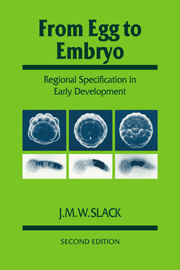Book contents
- Frontmatter
- Contents
- Preface to the second edition
- Preface to the first edition
- 1 Regional specification in animal development
- 2 The concepts of experimental embryology
- 3 Theoretical embryology
- 4 Hierarchies of developmental decisions
- 5 Development with a small cell number
- 6 Models for Man: the mouse and the chick
- 7 The breakthrough
- 8 What does it all mean?
- Appendix: How to write a program for development
- References
- Index
8 - What does it all mean?
Published online by Cambridge University Press: 16 October 2009
- Frontmatter
- Contents
- Preface to the second edition
- Preface to the first edition
- 1 Regional specification in animal development
- 2 The concepts of experimental embryology
- 3 Theoretical embryology
- 4 Hierarchies of developmental decisions
- 5 Development with a small cell number
- 6 Models for Man: the mouse and the chick
- 7 The breakthrough
- 8 What does it all mean?
- Appendix: How to write a program for development
- References
- Index
Summary
Embryos used to be very mysterious but our knowledge has now advanced so far that most of the mystery has gone. We can now imagine building an embryo ourselves if we were provided with the correct components, and in the Appendix that follows such a developmental program is presented to illustrate the principles involved. Regional specification was until a few years ago a neglected problem persued only by a dedicated few but has now become the best understood aspect of early development. By contrast, the poorly understood aspects are how the epigenetic codings are converted into shape changes (morphogenesis) and into visible pattern (terminal differentiation), and it is in these areas that the proposed program is most deficient.
The fantastic progress of the past few years has vindicated the idea that if you want to understand embryos you should study the embryo itself. Studying other developmental problems such as virus assembly or gene regulation in terminally differentiating cells is no substitute. In this work the heritage of classical experimental embryology has been of crucial importance and many of the concepts which arose from it are now again on the centre stage. The power of molecular biology has also begun to show itself, and when appropriately applied, as to Drosophila, it has decisively transformed the kinds of experiments we can do.
- Type
- Chapter
- Information
- From Egg to EmbryoRegional Specification in Early Development, pp. 278 - 281Publisher: Cambridge University PressPrint publication year: 1991

